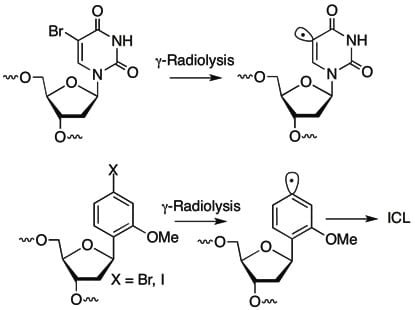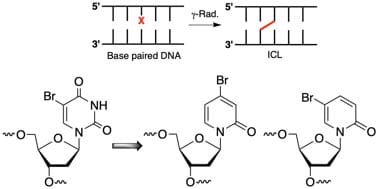Solid tumors often possess deficient vasculature for delivering O2 and other nutrients to cells. Ironically, the hypoxic character of solid tumor cells makes them less susceptible to the cytotoxic effects of gamma-radiolysis due to the involvement of organic free radicals in the chemical processes and the need for O2 to compete with thiols and “fix” DNA radicals produced upon irradiation. A long-standing problem in radiation mediated cell-killing concerns the development molecules that help overcome O2 deficiency in solid tumors. We designed molecules inspired by 5-bromo-2′-deoxyuridine that yield interstrand cross-links in DNA, selectively under hypoxic conditions.
These molecules are examined in vitro, as well as in cells using “pro-tide” versions of the modified nucleotides to examine incorporation in cells.
For relevant publications see:
•DNA Interstrand Cross-Linking Upon Irradiation of Aryl Halide C-Nucleotides. Hou, D.; Greenberg, M. M. J. Org. Chem. 2014, 79, 1877-1884.
•Bromopyridone Nucleotide Analogues, Anoxic Selective Radiosensitizing Agents that are Incorporated in DNA by Polymerases. Rudra, A.; Hou, D.; Zhang, Y.; Coulter, J.; Zhao, H.; DeWeese, T. L.; Greenberg, M. M. J. Org. Chem. 2015, 80, 10675-10685. (PMC: 4877698)


